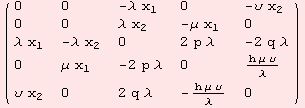Direct and semi-direct sum
The direct sum of the following two algebras with basis (![]() ,
,![]() ) and (
) and (![]() ,
,![]() ,
,![]() )
)
![]()
![]()
![]()

... is the algebra with basis (![]() ,
,![]() ,
,![]() ,
,![]() ,
,![]() ) and commutator [
) and commutator [![]() ,
,![]() ]=0.
]=0.
![]()

The next example shows the sum of 3-dimensional 1-Heisenberg algebra and (![]() ,+).
,+).
![]()
![]()


Note, {{{0}}} is the ad tensor of (![]() ,+).
,+).
![]()
![]()
The function we would like to explain is ad∠gl, which establishes the commutator tensor of a semi-direct sum algebra. The procedure makes a subalgebra of ![]() R act on a n-dimensional ad tensor as a set of derivations.
R act on a n-dimensional ad tensor as a set of derivations.
![]()
![]()
![]()
![]()

Another example: We setup a general matrix, to act on 1-Heisenberg.
![]()
![]()

![]()

We are interested in the set of possible derivations, thus we demand ad to satisfy the Jacobi identity. It turns out, that the space of derivations is a 6-dimensional vector space with coefficients {![]() ,
,![]() ,
,![]() ,
,![]() ,
,![]() ,
,![]() }.
}.
![]()
![]()


| Created by Mathematica (September 30, 2006) |